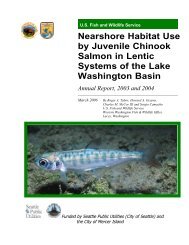2005 State of Mobility Report - City of Bellevue
2005 State of Mobility Report - City of Bellevue
2005 State of Mobility Report - City of Bellevue
You also want an ePaper? Increase the reach of your titles
YUMPU automatically turns print PDFs into web optimized ePapers that Google loves.
Commute Trip<br />
A trip from a person’s home to a work site with<br />
a regularly scheduled arrival time between 6:00<br />
a.m. and 9:00 a.m. inclusive, on workdays. The<br />
Commute Trip Reduction Act measures only<br />
weekday (Monday through Friday) commute trips.<br />
(Chapter 12)<br />
Commute Trip Reduction Act (CTR)<br />
1991 <strong>State</strong> legislation incorporated into the<br />
Washington Clean Air Act. The law establishes goals<br />
for the reduction <strong>of</strong> commute trip single-occupancy<br />
vehicle miles by the employees <strong>of</strong> large employers<br />
(with greater than 100 employees). (Chapter 12)<br />
Comprehensive Plan<br />
Adopted goals, policies, and projects necessary to<br />
manage progress toward a defined future level <strong>of</strong><br />
growth and development; mandated by the 1990<br />
Growth Management Act.<br />
Concurrency<br />
The concept <strong>of</strong> limiting land development if that<br />
development would increase congestion beyond<br />
adopted level <strong>of</strong> service standards. The 1990<br />
Growth Management Act and the <strong>Bellevue</strong> Traffic<br />
Standards Code set out the concurrency framework<br />
and requirements, respectively, that <strong>Bellevue</strong> must<br />
follow. (Chapters 2 and 3)<br />
Congestion Allowance<br />
As stated in the <strong>Bellevue</strong> Traffic Standards Code,<br />
the number <strong>of</strong> system intersections within a<br />
<strong>Mobility</strong> Management Area that may exceed the<br />
area-wide Level <strong>of</strong> Service standard. (Chapter 3)<br />
Customer Action Requests (CARs)<br />
Requests from residents for services or solutions<br />
to concerns within one or more <strong>of</strong> the<br />
Neighborhood Enhancement Program areas, such<br />
as transportation. (Chapter 6)<br />
Cut-through Traffic<br />
Traffic, especially commuter traffic, that is<br />
bypassing congestion on regional freeways and local<br />
arterials by using residential street “short-cuts.”<br />
(Chapter 2 and 6)<br />
Downtown<br />
The <strong>Bellevue</strong> Urban Center, also known as the<br />
Central Business District (CBD), where regional<br />
retail, commercial, and service activities are focused.<br />
The Downtown center is bounded by NE 12th Street<br />
to the north, 112th Avenue NE to the east, Main<br />
Street to the south, and <strong>Bellevue</strong> Way to the west.<br />
Eastside<br />
A geographic area that includes the King County<br />
communities east <strong>of</strong> Seattle, including <strong>Bellevue</strong>.<br />
Environmental Impact <strong>State</strong>ment (EIS)<br />
Prepared in conjunction with major projects or<br />
programs <strong>of</strong> projects, an EIS documents potential,<br />
cumulative impacts to the environment (such as air<br />
quality, noise, earth and water resources, and plants<br />
and animals) and the citywide transportation system<br />
from the proposed improvement in the context <strong>of</strong><br />
planned land use. (Chapters 2 and 4)<br />
Financially Constrained<br />
A concept applied to some plans, such as<br />
the Transportation Facilities Plan, that allows<br />
projects to be included without specific funding<br />
commitments, if the total cost <strong>of</strong> those projects<br />
does not exceed the <strong>City</strong>’s transportation revenue<br />
projections for the identified period. (Chapter 4)<br />
FlexPass<br />
An annual transportation benefit purchased by<br />
employers that combines transit, rail, vanpool, and<br />
emergency taxi ride features in one program, which<br />
is administered by King County Metro. (Chapter 12)<br />
Growth Management Act (GMA)<br />
<strong>State</strong> legislation enacted in 1990, and amended<br />
in 1991, requiring counties and cities to create<br />
cooperative regional strategies to manage growth<br />
and to adopt comprehensive plans and regulations<br />
to guide the implementation <strong>of</strong> those strategies.<br />
(Chapters 2-4)<br />
<strong>2005</strong> <strong>State</strong> <strong>of</strong> <strong>Mobility</strong> <strong>Report</strong> 119

















